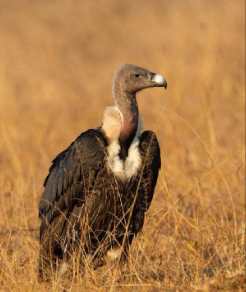Long-Billed Vultures Show Recovery in Mudumalai Reserve
Why in the news?
A recent study revealed a 74% breeding success rate for the critically endangered long-billed vultures in Mudumalai Tiger Reserve, signalling a positive trend in their conservation efforts.
Study Highlights:
- A recent study shows a promising recovery for the critically endangered long-billed vulture, with a 74% breeding success rate recorded between 2015 and 2021.
- The study was conducted in the Mudumalai Tiger Reserve (MTR), Tamil Nadu.
- The long-billed vulture, a medium-sized scavenger with a distinct long beak, primarily feeds on carcasses and is native to India, Pakistan, and Nepal.
- Despite their native status, their population has declined by 97-99% due to poisoning caused by the veterinary drug diclofenac.
About Mudumalai Tiger Reserve’s Role:
- The Mudumalai Tiger Reserve, located in the Nilgiris District of Tamil Nadu, provides essential habitat for these vultures.
- Positioned at the intersection of Tamil Nadu, Karnataka, and Kerala, MTR shares borders with the Wayanad Wildlife Sanctuary and Bandipur Tiger Reserve.
- MTR hosts diverse vegetation like tropical evergreen and moist deciduous forests, supporting a wide range of wildlife, including elephants, tigers, and deer.
Conservation Efforts and Hope:
- The vulture population’s rebound in MTR marks a hopeful turn in conservation efforts for this species.
- This recovery comes despite the critical challenges facing the species due to habitat loss and diclofenac poisoning.
- Ongoing efforts to protect their habitat and ensure safe breeding conditions will be key to sustaining this positive trend for the long-billed vulture.
Key facts about Long-billed vulture:
- Scientific Name: The Long-billed vulture is an Old World vulture native to Asia.
- Common Name: Indian Long-billed Vulture, due to its longer beak.
- Size: Medium-sized, bulky scavenger; females are smaller than males.
- Diet: Feeds primarily on the carcasses of dead animals.
- Habitat: Typically found in savannas, open habitats near villages, cities, and cultivated areas.
- Distribution: Native to India, Pakistan, and Nepal.
- Conservation Status: Critically Endangered (IUCN Red List).
- Population Decline: A 97-99% decrease in population has occurred.
- Major Threat: Poisoning from the veterinary drug diclofenac, which was administered to working animals to relieve joint pain, has been toxic to vultures feeding on their carcasses.
Sources Referred:
PIB, The Hindu, Indian Express Hindustan Times
Watch on Youtube : Long-Billed Vulture’s Comeback:Conservation Success in Mudumalai Tiger Reserve 🦅 | 74% Breeding Rate





